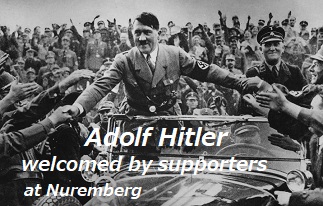
(前述の)イソップ(童話)の類推をヒットラーの台頭にあてはめてみよう。ニンジンはナチスの綱領(たとえば,利子の廃止も含む)にあたる(該当する)。ロバは下位の中産階級にあたる(注:interest 利子,利息を東宮氏は利権と訳出)。羊(の群)と羊を先導する者は,社会民主党員とヒンデンブルグにあたる(該当する)。豚は(「豚」と言っても,その不運な面に関してだけのことであるが)強制収容所に入れられて犠牲になった人々が該当し,芸のできる動物はナチスに敬礼をする幾百万(の民衆)が該当する。
最も重要な組織は,おおよそ,その組織が行使する権力の種類によって区別することができる。軍隊と警察は肉体に対する強制的な権力を行使する。経済組織は,主に,賞罰を誘引物や制止物として利用する。学校,教会,政党などは,世論(人々の意見)に影響を及ぼそうと企てる。しかし,こうした区別も,そう明確に割り切れるものではない。いかなる組織も,自分に特有な権力に加えて,他の形態も用いるからである。
Chapter III: The Forms of Power, n.4
Let us apply these Aesopian analogies to the rise of Hitler. The carrot was the Nazi programme (involving, e.g” the abolition of interest) ; the donkey was the lower middle class. The sheep and their leader were the Social Democrats and Hindenburg. The pigs (only so far as their misfortunes are concerned (misspelling: con-concerned) were the victims in concentration camps, and the performing animals are the millions who make the Nazi salute.
The most important organizations are approximately distinguishable by the kind of power that they exert. The army and the police exercise coercive power over the body; economic organizations, in the main, use rewards and punishments as incentives and deterrents; schools, churches, and political parties aim at influencing opinion. But these distinctions are not very clear-cut, since every organization uses other forms of power in addition to the one which is most characteristic.
出典: Power, 1938.
詳細情報:https://russell-j.com/beginner/POWER03_040.HTM
